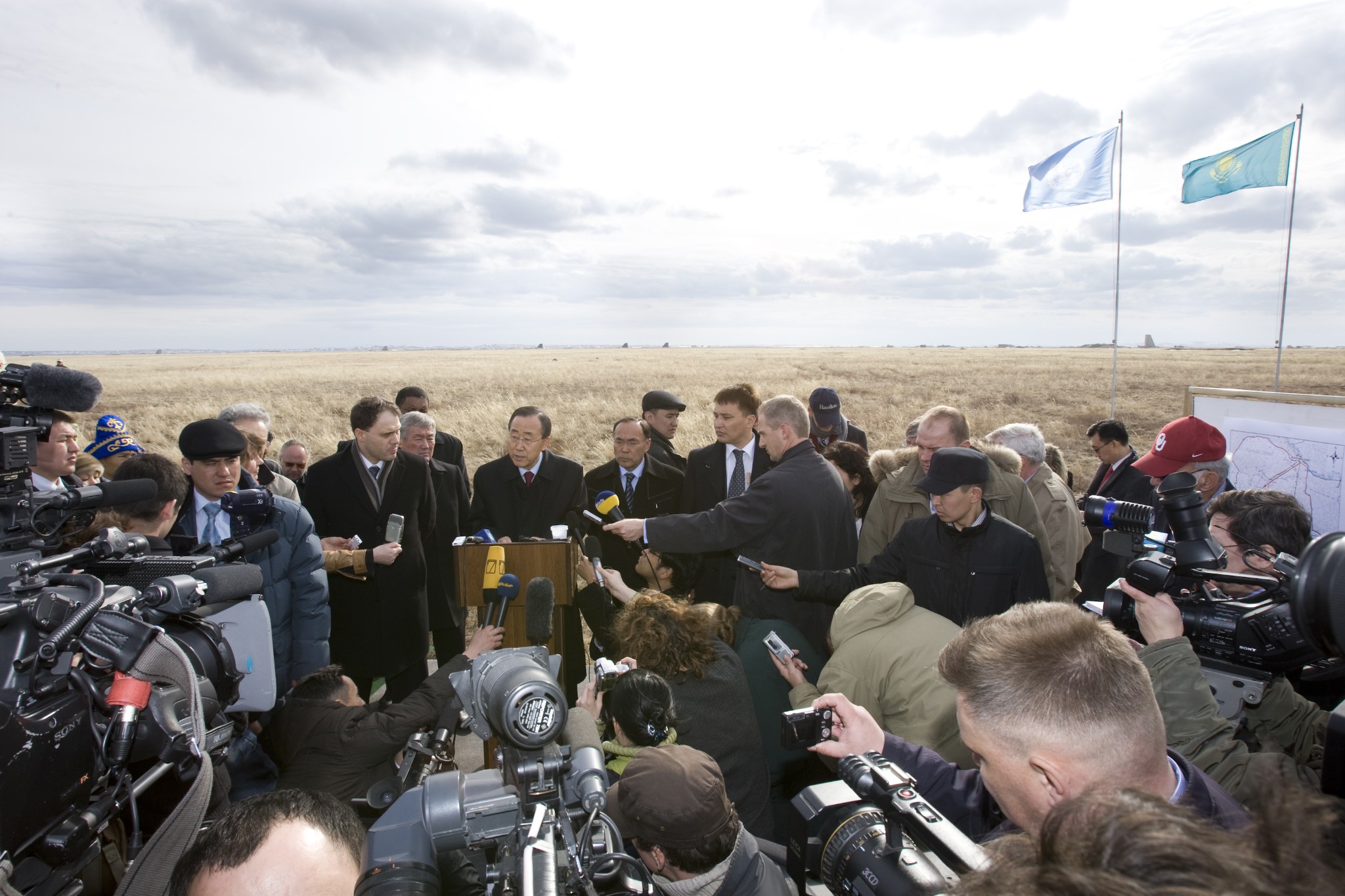 UN Sec.-Gen. Visits Semipalatinsk Nuclear Test Site (UN Photo / Eskinder Debebe)
UN Sec.-Gen. Visits Semipalatinsk Nuclear Test Site (UN Photo / Eskinder Debebe)
Just Not That Into HEU: Kazakhstan’s Nuclear History, Security, and Identity
At the International Atomic Energy Agency’s (IAEA) General Conference in Vienna at the end of September, the Kazakh Energy Ministry and the U.S. Department of Energy’s National Nuclear Safety Administration (NNSA) announced that all of Kazakhstan’s unirradiated highly enriched uranium (HEU) had been eliminated. The two countries also signed a joint statement reconfirming that they would convert one of Kazakhstan’s research reactors, IVG.1M, from using HEU to low enriched uranium (LEU). This follows the conversion of its WWR-K reactor from HEU to LEU in 2017.
Kazakhstan’s cooperative nuclear security efforts have only increased in recent years as the country proclaims itself as a “model of nuclear disarmament” and sees this as a large part of its contemporary identity as a nation. One of Kazakhstan’s top policy priorities in the United Nations is nuclear security, with a particular focus on nonproliferation, disarmament, and banning nuclear testing. Although struggling to mitigate concerns of nuclear breaches, Kazakhstan has acted on a strong desire to extricate itself from its nuclear-ridden history, leading many to praise its efforts as an international exemplar of the nonproliferation regime.
Kazakhstan’s Soviet-era “nuclear shadow”
As a former important strategic site for the USSR, Kazakhstan inherited 1410 Soviet strategic nuclear warheads and some tactical nuclear weapons, at the time the world’s fourth-largest nuclear arsenal. But Kazakhstan transferred its last remaining Soviet-era nuclear weapons to Russia in 1995, eager to rid itself of the remains — both metaphorically and physically — of its nuclear past.
The Semipalatinsk Test Site (STS) near Kurchatov hosted the first Soviet nuclear test and served as a Soviet atomic bomb test site for over 400 tests from 1949 to 1989. STS closed in August 1991, tying closely with the formation of contemporary Kazakhstan and its nuclear policies. Anti-nuclear movements like Nevada-Semipalatinsk (1989-1991) have ensured the memory of STS remains close, leaving its mark on people and places as a haunting reminder of its nuclear legacy.
But Kazakhstan’s history of nuclear nonproliferation, disarmament, and safety efforts did not end there. In 2013, Kazakhstan signed a bilateral framework with the U.S. through the Nunn-Lugar Cooperative Threat Reduction (CTR) program that would become a defining agreement for the country’s denuclearization efforts. Through CTR, the U.S. helped to secure STS by closing off and sealing 181 test tunnels and 13 bore holes but left the remaining plutonium inside, eventually cooperating in a secret international operation to fill the paths to prevent militant actors from obtaining the nuclear material.
Additionally, Kazakhstan has happily reaped the economic and strategic rewards of denuclearization efforts with the U.S. The nation reportedly received $10-20 million in “cash and in-kind assistance” to covertly transfer 600 kilograms of weapons-grade uranium to the U.S. through Project Sapphire. In doing so, Kazakhstan declared that it “acted as a state … that understands its responsibilities for the world and that wanted to remove the risk of proliferation.”
Kazakhstan became a party to a number of significant nuclear agreements, including START I and the Nuclear Non-Proliferation Treaty (NPT) in 1994, the Comprehensive Nuclear-Test-Ban Treaty in 2002, the Nuclear Suppliers Group (NSG) in 2002, and the Central Asian Nuclear Weapon Free Zone in 2006. Kazakhstan also signed the Treaty on the Prohibition of Nuclear Weapons in 2018, which plays a unique sociopolitical role by allowing states to demonstrate their desire to ban nuclear weapons despite the treaty’s lack of sufficient ratification.
The future of Kazakhstan’s nuclear status
As the world’s leading producer of nuclear fuel, Kazakhstan’s program is dedicated to activities as a nuclear exporter for civilian use, setting a standard for a continued peaceful nuclear path forward. The country has three active research reactors — WWR-K, IVG.1M, and IGR; the latter two are located at the Kazakhstan National Nuclear Center (NNC) where STS once stood. Additionally, having shut down its sole nuclear power plant in 1999, Kazakhstan has no power generation capacity. However, in 2014, Russia and Kazakhstan signed a preliminary cooperative agreement for the development of a new plant.
But Kazakhstan toes the line when it comes to providing nuclear fuel to other nations, putting faith in its trade partners to do the right thing. Kazatomprom, the state-owned nuclear production company, has forged import-export relationships with countries including Russia, China, the U.S., and Iran. Kazakhstan cooperated in P5+1 talks for the Joint Comprehensive Plan of Action (JCPOA) and assisted in its implementation while, like Russia, selling yellowcake to Iran within the JCPOA’s mandated limits. Nevertheless, its deal with Iran was subject to approval by P5+1 countries.
Kazakhstan is proudly the home of the IAEA LEU Bank, which acts as a source of nuclear fuel assurance for IAEA member states, uplifting Kazakhstan as a supporter of responsible civilian nuclear activity. However, multiple radioactive material scares have plagued the nation’s efforts to promote itself as a cornerstone of global nuclear security. While its national and political identity as a zealous advocator for a tenuous nuclear-weapons-free future continues to be tested, Kazakhstan’s status as a major nuclear exporter and champion of nuclear security will remain extraordinarily important going forward.





